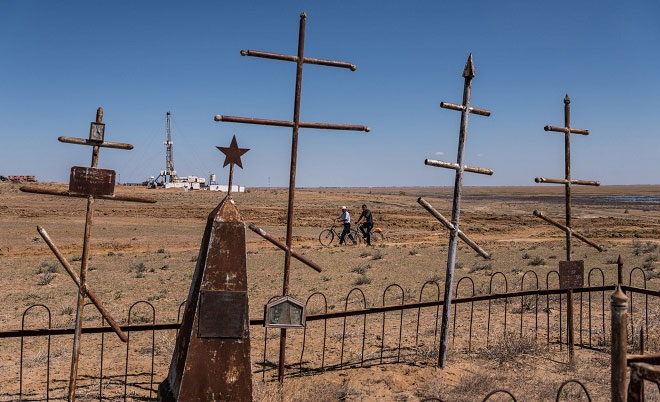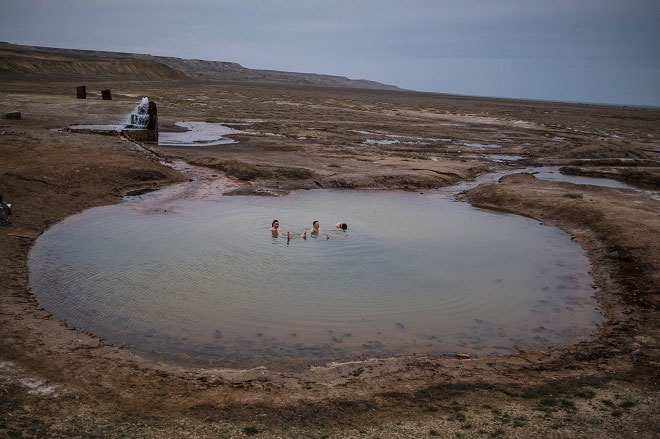The world's fourth-largest sea disappeared completely, inertly dry
The town of Muyank in Uzbekistan used to be a busy seaport dedicated to fishing needs, but climate change and human impacts have caused the area to face an ecological disaster.
New York and Times reporters were present in Muyank, Uzbekistan on a day when a storm came. This makes the local ecologist Gileyboi Zhyemuratov even more sad.

The Aral Sea has now disappeared completely.
This land used to be a busy port town by the Aral Sea, but the sea was completely empty, leaving residents with ecological disasters.
"Just open the door and see everything white as covered in snow," said the 57-year-old man. Mr. Zhyemuratov is a descendant of the generation of fishermen in Muyank, who decide to stay in the town even without fish.
During the 3 days, the storm of draft and completely isolated the town of Muynak with the outside world. Few people know that this is the region with the fourth largest enclosed sea in the world. Called a closed sea because they are separate from the sea and the oceans, but have salinity equivalent to the ocean.

Guests bathe in the lake where once used to be the Aral seabed.
Extreme weather phenomenon makes life difficult for people because of crop failures.
Vladimir Zuev, a former Russian pilot, who is now a regional tour guide, has become accustomed to living in Muyank.
"Can't see anything," Zuev said. "Dry salt is caught up in the winds, they stick to the skin and it is very difficult to clean. Even washing with water does not lose," he describes.
Surprisingly, the area is gradually dying as Muyank has especially attracted tourists over the years.'People want to see the ecological disaster,' said Vadim Sokolov, head of the International Aral Marine Conservation Foundation in Uzbekistan.
The dry land, only this land and rock used to be the place where the waves overlap. Now rusted boats are left in the sun to become tourists' shooting locations

Tourists flock to the area to witness firsthand the effects of environmental change.
Ali and Poline Belhout, the couple from Paris, France, decided to stop for a few days in Muynak on a tour around the world.'It is sad to know that this place used to be the sea, now it is only a graveyard of boats , ' Belhout said.
The Aral Sea has practically disappeared since 25 years ago. Five countries in Central Asia were then unable to agree on a solution, including water distribution.
The cause of the Aral Sea was drained for Soviet leadership decision Nikita S. Khrushchev more than 60 years ago. That is when Khrushchev decided to industrialize agriculture in Central Asia , although this land frequently faced arid weather.
The two rivers Amu Darya and Syr Darya, which supply water to the Aral Sea, are fully exploited to irrigate the fields of wheat and cotton. Backward farming practices in that period lost 80% of the water used for irrigation.

Villagers Akespe, Kazakhstan, cleaned up the sand and winded the area every day.
also contributes to the faster evaporation of water in the sea. Glaciers in Turkmenistan and Kyrgyzstan mountains often flow into the river Amu Darya and Syr Darya are also exhausted.
"The current main goal is to minimize the impact of the Aral Sea catastrophe , " said Boriy B. Alikhanov, head of Uzbekistan's Action for Ecology party. "Throughout the history of modern humanity, the phenomenon of a disappearing sea has never happened in just one generation , " he said.
Meanwhile, Helena Fraser, the head of the United Nations Development Program in Uzbekistan, said: 'This is not only a tragedy, but also a danger that happens right before our eyes.'
It's sad to know that Muyank used to be a bustling seaport with 25,000 people. An estimated 20% of fish consumed in the Soviet Union at that time came from 30 species of fish in the Aral Sea.
- AMD lost its fourth quarter in a row
- The 200m-wide lake disappeared without a trace after a night
- Computer Acer maintains the fourth position worldwide
- The mystery of cruise ships suddenly disappeared at sea
- Poopó Lake 1000km2 wide suddenly disappeared
- Giant snakehead sea turtle
- The 300-year stone bridge disappeared, causing the villagers to be confused
- The truths always amaze you about the biological world
- The famous Indian tiger disappeared mysteriously
- 'Time loophole' and mysterious disappearances
- 10 ancient cities have disappeared completely from the world map
- France blocks 'gate connecting the worlds'
 Is the magnetic North Pole shift dangerous to humanity?
Is the magnetic North Pole shift dangerous to humanity? Washington legalizes the recycling of human bodies into fertilizer
Washington legalizes the recycling of human bodies into fertilizer Lightning stone - the mysterious guest
Lightning stone - the mysterious guest Stunned by the mysterious sunset, strange appearance
Stunned by the mysterious sunset, strange appearance